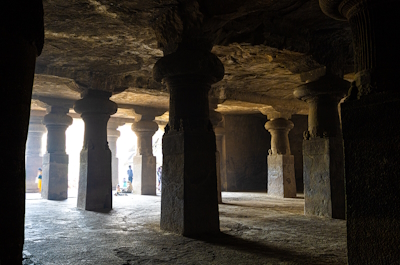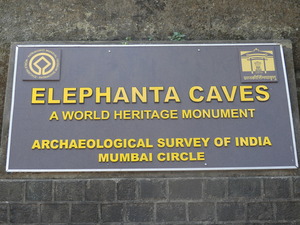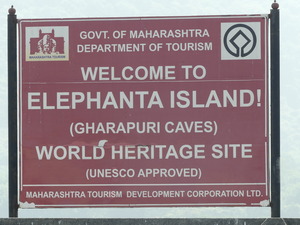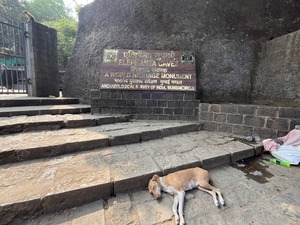Elephanta Caves

The Elephanta Caves hold great examples of Indian rock-cut art and architecture.
The reliefs and sculptures in the caves have been dated between the 5th and 8th centuries. The Hindu caves are dedicated to the god Shiva. These were regular Hindu places of worship, and during the festival of Shiva continue to be so. The caves are hewn from solid basalt rock. All caves were painted in the past, but only traces remain.
Community Perspective: As it is easily accessible from Mumbai city centre on a 1hr boat ride from the Gateway of India, it’s a nice escape from the city. Cave 1 is the really impressive one. Ignore the scam guides. Frederik’s review is a good place to start as he shares his visiting experience and knowledge of Hinduism.
Map of Elephanta Caves
Load mapCommunity Reviews
Carlo Sarion
Philippines/New Zealand - 04-Jan-24 -

The previous reviews pretty much described what to expect from a visit to the Elephanta Caves, a collection of rock-cut cave temples dedicated to Shiva. Here are some observations and updated info from my visit to the island in January 2024.
1. Logistics - getting to the caves remains the same: you get on a ferry from the Gate of India, sail for about an hour, catch the toy train upon arrival, walk uphill and dodge eager vendors, and pay the entrance tickets. Unless I missed it, there didn't seem to be an option for "luxury" ferry anymore, as everyone got one type of ticket at INR 260 return, with an option to pay extra INR 10 for a seat on the upper deck. I took the toy train (INR 18) and paid INR 5 for the local tax (or 'village' entry fee). I also decided not to buy a guide booklet being sold for INR 180 as I've had internet connection and knew that there would be info panels at the caves. As usual, foreign tourists had to pay a significantly higher fee (INR 600) than the locals, but we all get used to it, I guess. By the way, heaps of garbage on the shores of the island, and it really ruins the experience for me.
2. Cave 1 - as mentioned in previous reviews, cave 1 is the highlight and tells what this site is all about. Some comments on the things you'd see in Cave 1:
- Columns - I find them quite interesting as the capitals of these columns somehow resemble that of one type of ancient Egyptian columns.
- Shrines - A shrine housing a massive linga is found to your right upon entry (on the western half of the cave). This shrine has a square plan and is surrounded by giant guardians, though some are significantly damaged. The east shrine is connected to Cave 1 through an open courtyard. Note the carved wall on the west side of the east shrine, although you'd need a torch to appreciate the details. A tiny shrine is also found on the west side of Cave 1, where I have seen some devotees remove their shoes upon entry.
- Sculptures - Various representations of Shiva are seen on the walls of Cave 1, although many of them had been vandalised, mutilated, or eroded. My personal favourites are the (1) Nataraja Shiva (dancing Shiva), (2) Andhakari Shiva (depicts a terrifying Shiva slaying the malevolent asura Andhaka), (3) Gangadhara Shiva (a relatively intact sculpture depicting Shiva, Parvati, and the triple-headed Ganga), and the main attraction, (4) the Sadashiva, which shows a three-headed Shiva.
3. On Sadashiva - speaking of Sadashiva, Wikipedia and Britannica refer to Sadashiva as trimurti, a term that Frederick attested to be confusing. We often associate the term trimurti with the trifecta of Brahma, Vishnu, and Shiva. However, in Shaivism, trimurti in this case simply refers to the 3 heads that represent various aspects or facets of Shiva. But you know what's more confusing? An info panel at the entrance of the site describes Sadashiva as panchamukha linga ('pancha' is five and 'mukha' means face in Sanskrit). This means that this sculpture represents Shiva having 5 faces, although only three are seen as the 4th one is behind the bust and thus implied, while the 5th one is never carved as it is beyond "the sight of the mortals". As this website attests, the use of trimurti here is a misunderstanding.
4. Other caves - I'd like to emphasise that the other caves (caves 2 to 5) are worth visiting as they would give you an idea of what the caves look like at varying levels of excavation and development. Cave 3 also has an impressive facade with rows of massive pillars.
5. Five or seven? There are actually 7 caves on the island. The other two are located on a hill opposite to where the five caves are. One website says that cave 6 was converted into a church while cave 7 had several Buddhist stupas around it. I only learned about the two other caves upon re-viewing the map of the site when I arrived back in Mumbai, so I kinda regret not knowing about them before visiting. For future reviewers of this site, it would be handy to have these two other caves included in your personal reviews. An excellent blog entry on Elephanta Island by a photographer named Kevin Standage gives a glimpse of these less-visited caves.
Lastly, it is natural to compare Elephanta Caves with Ajanta and Ellora as they are all rock-cut temples. While I have not been to the other two, comparing them may be quite unfair as they are all quite different: Ajanta is Buddhist, Elephanta is Hindu (of Shaivism tradition), and Ellora is multi-religious (Hindu, Buddhist, and Jain). I guess the best way to appreciate Elephanta is to visit it first and then gradually move to the other, bigger caves. This allows for a more informed comparison and may preclude disappointment if you find the other caves to be much more impressive.
Clyde

I visited this WHS in November 2016. I had an early morning flight from Goa to Mumbai and so I opted to beat the rush hour morning traffic and head straight to the Gateway of India and the Taj Palace & Tower.
I bought my tickets for the "luxury" ferry to Elephanta Island which is less crowded and in a slightly better state than the "normal" ferry. I also opted to pay the extra 10 rupees to stay on the upper deck which is even less crowded and great for taking photos of the Gateway of India.
After around one hour in the Arabian Sea, I set foot on Elephanta Island and decided to walk along the jetty instead of waiting for the tourist train to depart. After a number of stalls, 5 rupees are collected as local tax and then you have to walk uphill for a while before getting to the Elephanta Caves entrance.
There are 5 Hindu caves in total even though the main cave has the most important sculptures. Having visited Ellora, Ajanta and Badami Caves, I failed to appreciate any OUV in this WHS and apart from the 6 metre Trimurti of Elephanta (picture) showing the three faces of Shiva all the other sculptures are damaged and only worth viewing as a national heritage or pleasant sidetrip from Mumbai.
However, I don't think I'll ever forget the Elephanta Caves as after my visit I found out that the 1000 and 500 rupee notes had been banned overnight and were no longer legal tender. Perfect timing I thought as I had just exchanged all my Euros to 1000 and 500 notes the day before which meant I had to waste more than 2 hours at the bank to exchange all my money before I could continue my trip towards Aurangabad.
Frederik Dawson

After lunchtime from the Gateway of India, a symbolic entrance to subcontinent during the British Empire in Mumbai, I took a boat ride to see the Elephanta Caves on the island of the same name just outside the metropolis. The trip took exactly one hour to reach the island passed many navy bases, cargo ports, petroleum jetties and a nuclear power plant, if not because of UNESCO protection, I believe Elephanta Island will be a part of Mumbai electrical grid production.
On the island I had been approached by the typical guide scam who always claimed that you need a proper guide to enter the caves, just ignored them. I rode the mini train from port to the island. From the train parking, I had to pay a small landing fee, and then I walked thru many souvenir shops and restaurants, these shops made the island like a market place and seemed to me that many tourists loved shopping even before seeing the caves. Since the caves were located on the hill in the middle of island, the way to the caves required some hiking. Again along the hiking route in the forest were full with souvenir shops and warning signs for monkey attack. On the hill there was another ticket counter but this time for the caves. I immediately followed people to see the cave no.1 which I believed the sole highlight of Elephanta. The cave was quite impressive than my original though. The cave was adorned with many Shiva depictions. The beautiful Shiva Nataraja next to the main entrance was really impressive even in partial ruined state. But the centerpiece of the cave was the big statue of three heads Shiva. I was really confused as many travel websites called the statue as Trimurti, from my understanding Trimurti means Brahma, Shiva, and Vishnu together, and the depiction I saw was no way Brahma and Vishnu. Strangely I got the answer couples of day later while I was in Old Goa; I met an ASI archaeologist, so I asked him the question and he explained to me that my understanding was correct and the depiction should be called Maheshmurti, three heads Shiva, not Trimurti.
There were many other interesting and beautiful depictions in the caves, and I found the cave to be a great place to revive and test my Hinduism knowledge which I learned from my Indian friend when I was in high school especially the story of Shiva. I decided not to see other caves as I heard there was nothing much to see and I wanted to go back to Mumbai before sunset, so I walked back to the pier and ended my Elephanta Caves tour within 1.5 hour. In my opinion, Elephanta Caves should not be compared with Ellora or Ajanta, since the size of those two sites will definitely make Elephanta to be an underdog, but the Shiva depictions on Elephanta are more refined and graceful than Ellora For me Elephanta Caves is something like a small museum that possessed one great masterpiece that must see in India.
Gopala Krishna
The Elephanta caves are a wonderful link to our past. We caught a boat from Belapur to the caves. A toy train is available to take us close to the caves. Unfortunately most of the tall statues were destroyed and only a few are still standing. However the famous caves are still worth a visit. There were lots of monkeys too.
Ian Cade

First things first; the enormous carvings in the first cave really are impressive, and rank alongside the very best at Ellora/ Ajanta. However I have to say this was perhaps my biggest disappointment on my little South Asian jaunt. Aside from the impressive first cave there is really nothing else of note. The other five or six caves at the site are all devoid of decoration and some look little more than natural caves, apparently the soft stone made it difficult to carve lasting art works.
Cave 1 really is impressive and even on its own justifies the inscription on the World heritage list. I was hugely impressed by the Trimurti, a massive depiction of Shiva with three heads. The size of the other sculptures really was remarkable as well. But that was about it. I walked off in anticipation of seeing more sculptures but saw nothing but empty caves. After about 15 minutes I turned back and spent some more time in the main cave, then headed home.
This was the only site where I had trouble getting the free entry that was granted by it being Indian World Heritage week, but the attendants did eventually relent for me, but carried on charging everyone else despite the large signs saying otherwise.
The caves are on an island in Mumbai harbour and it was a nice trip out there, it take about an hour each way and boats leave from the Gateway of India. This meant I got to pay homage to my earliest travel hero, Michael Palin, by arriving at the gate from the sea.
It made a nice half day trip away from the hustle of Mumbai, and I would say it was worthwhile; however I was disappointed by the limited nature of the site.
[Site 5: Experience 3]
Stewart ayukawa
Elephanta caves was a pleasant excursion near Bombay. There were monkeys and a Shiva Lingam
Christer Sundberg

If you have overloaded your senses and need to get out of Mumbai for a day, a slow cruise to the Elephanta Island and the Elephanta Caves is exactly what you need.
Some 9 km north of the Gate of India, in the Sea of Oman, the Elephanta Island and its caves are the premier tourist attraction of Mumbai. The 50-minute cruise takes you from one world to another. Suddenly the air is fresh and the sound of the bustling city is far away.
Little is known about the origin of the Elephanta Caves but they are thought to have been created between 450 and 750 AD when the island was known as Gharapuri (Place of Caves). The Portuguese renamed the island Elephanta because of a large stone elephant near the shore. The statue collapsed in 1814 and the British then moved it to the mainland.
The Elephanta Caves consist of one main cave and several smaller. In the main there is a number of large sculpted panels, all relating to Shiva. Some of the rock surfaces are finely finished whereas some are unfinished bare rock. In the main cave there is an enormous central bust of Shiva with its eyes closed in eternal contemplation.
Elephanta is certainly worth a visit but foremost its a nice escape from Mumbai for half a day. Compared to the Ajanta and Ellora caves, that I later visited they tend to fall down slightly in rank.
Community Rating
- : Philipp Peterer Yinming Zhang Joaofg RahulSharma Amitlchoudhuryjbp Priyaranjan Mohapatra
- : Travelure Mkandasa Laurine Campmany Ivan Rucek
- : Craig Harder Tarquinio_Superbo Elisabeth Fransisca Situmorang BMuramatsu Aspasia Christoph
- : Els Slots Jeanne OGrady Stanislaw Warwas Alexander Lehmann
- : Wojciech Fedoruk Lichia Subhayan_svnit Frederik Dawson Hanming Riccardo Quaranta Zoë Sheng Lucio Gorla Adiaro18 Eric PK YAO WEI Shandos Cleaver Tevity GerhardM S. Anril Tiatco Martina Rúčková Bernard Joseph Esposo Guerrero Xiquinho Silva
- : Randi Thomsen Svein Elias Solivagant Juropa Kurt Lauer Ian Cade Monica Tasciotti Sachin Luke LOU Mikko Chalamphol Therakul
- : Clyde Philipp Leu David Marton Carlo Sarion Lukasz Palczewski
- : Szucs Tamas Mahuhe
Site Info
- Full Name
- Elephanta Caves
- Unesco ID
- 244
- Country
- India
- Inscribed
- 1987
- Type
- Cultural
- Criteria
-
1 3
- Categories
- Archaeological site - South (East) Asian
- Link
- By ID
Site History
1987 Inscribed
Site Links
Unesco Website
Official Website
Related
In the News
Although the tourism department is trying to develop Elephanta island in a way appropriate for a world heritage site, rehabilitation of the shopkeepers is proving to be a major roadblock.Conservationists and tourism officials agree that Elephanta will not regain its historical pristine look without the removal of these shops. There are about 25 shops, all unauthorised, along the stairway leading from the jetty to the caves. (2007.02.25)
Connections
The site has 17 connections
Art and Architecture
Constructions
Geography
History
Human Activity
Individual People
Religion and Belief
Timeline
Trivia
Visiting conditions
Visitors
196 Community Members have visited.
The Plaque
 (photo by Clyde)
(photo by Clyde) (photo by Clyde)
(photo by Clyde) (photo by Els)
(photo by Els)